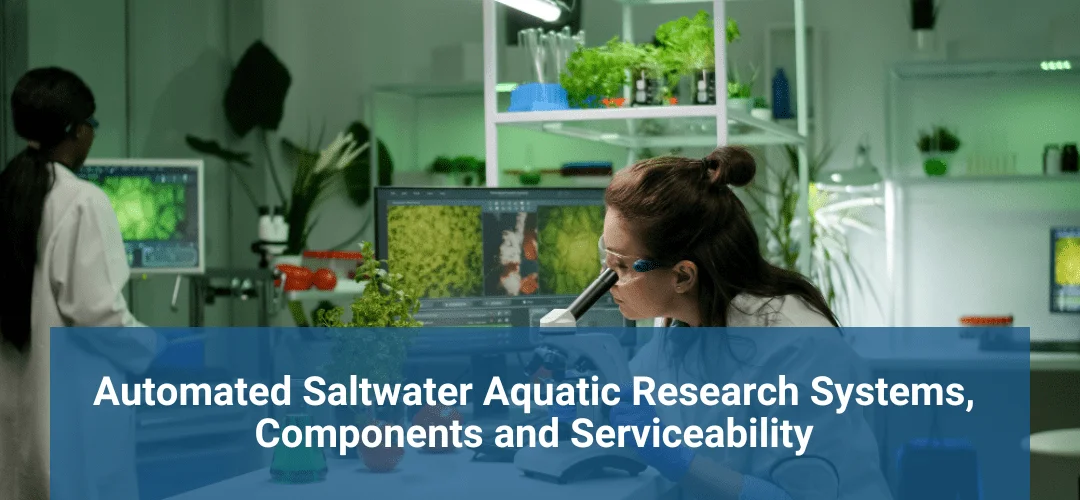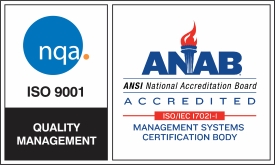Automated Saltwater Aquatic Research Systems, Components and Serviceability

Saltwater research systems are used in many research applications, ranging from marine biology studies to environmental monitoring. These research areas are becoming increasingly large-scale and complex; hence, automation of such systems controls and sustains these environments. Automated saltwater aquatic research systems maintain consistency in the settings with high accuracy and decrease dependency on labor for the management of such complex settings.
What is Automated Saltwater Aquatic Research Systems?
The saltwater aquatic research systems are automated and maintained to mimic natural marine settings within controlled laboratory. These systems hold a significant position for experiments on marine organisms, including fish, invertebrates, and microorganisms. Automation of these systems is done through the combination of different main parts, including sensors, controllers, and monitoring software, which are used to maintain water quality, temperature, salinity, and other vital parameters.
Indeed, technological advancement of automation capabilities has driven aquatic research to a new frontier by offering the ability for continuous monitoring and precise control over experimental conditions. These can be made to run over protracted times with minimal human intervention, thus assuring the reliability and reproducibility of results.
Core Components of Automated Saltwater Aquatic Research Systems
Water Quality Monitoring Systems
- Sensors: Water quality sensors are the backbone in any automated aquatic research system. They constantly monitor water quality parameters such as pH, temperature, salinity, and dissolved oxygen, apart from ammonia levels. Further, they work to provide real-time data in order for immediate adjustment to be made to maintain optimum conditions for the organisms being studied.
- Controllers: Controllers take input provided by sensors and, accordingly, provide the correct adjustments to keep the quality of water within set threshold values. If the salt levels have decreased, for example, a controller can activate a pump that infuses more saltwater into the system.
- Data Logging and Analytics: Most of the automation systems include features of data logging whereby the historical data is stored for analysis. This is a very important dataset in order to understand the trend, diagnose issues, and make decisions on system management.
Filtration Systems
- Mechanical Filtration: They are supposed to remove solid wastes from the water. Most of the automated systems employ skimmers, sediment traps, and mechanical filters to keep the water clear of particulates.
- Biological Filtration: The biological filters use the helpful bacteria to degrade the injurious substances like ammonia and nitrites into less toxic nitrates. The automated systems make sure these filters are kept up regularly and monitor for the development of harmful chemicals.
- Chemical Filtration: Chemical filtration involves a kind of filtration in which either the activated carbon or other chemical mediums are used in order to get rid of dissolved organic compounds and toxins from the water. Automation in the case of chemical filtration does preliminary monitoring when the saturated level is reached and gives an alert if the medium needs replacement.
Lighting Systems
- Photoperiod Control: This includes the automated lighting systems mimicking natural day-night cycles through photoperiod control, very important in maintaining health and behavior in marine organisms. These can be programmed for changes in light intensity and photoperiod that correspond to seasonal changes.
- Spectrum Control: Various marine organisms have optimal light spectra requirements for better growth and reproduction. Automation enables precision control of the light spectrum to ensure that the correct wavelength is provided for the needs of the organism at hand.
Feeding Systems
- Automated Feeders: These automated feeders release food at regulated times to ensure that the organisms receive adequate nutrition at all times without overfeeding. They can be programmed to deliver varied feeding schedules depending on the requirements of different species.
- Nutrient Monitoring: Beyond feeding, the automated systems can monitor nutrient levels in the water for prevention of overfeeding and its resultant waste product accumulation. It helps maintain water quality and also reduces the possibilities of algal blooms.
Temperature Control Systems
- Chillers and Heaters: Maintenance of water temperature within appropriate limits is necessary for the survival and good health of marine organisms. Chillers and heaters are used to regulate temperature within narrow limits, as the ambient temperature of automated systems fluctuates.
- Redundancy and Backup: These automated systems usually contain double or redundant temperature control systems that could take over in case of failure. This becomes important in long-term studies where even short-term variation in temperatures can compromise a result.
Water Circulation and Flow Control
- Pumps and Powerheads: Efficient circulation is essential in saltwater research systems to maintain stable water quality. A salt water circulation pump, along with powerheads, continuously moves water throughout the system to ensure proper flow at all times. The right water flow supports critical processes such as oxygenation, nutrient distribution, and waste removal, ultimately helping maintain the overall health of the marine environment.
- Flow Monitoring: Sensors can monitor the flow rate, hence adjusting the pumps accordingly to maintain consistent water movement. Automated systems also can simulate natural water currents as well as tidal patterns that are integral components in the behaviors and welfare of certain marine species.
Alarms and Alerts
- Real-time Monitoring: An automated system provides the capability of sending alarms or notifications in the case of some deviation from the set parameters. For example, in case the pH level falls out of a normal, safe range, that may trigger an alert via email or SMS that would call for immediate action.
- Fail-safes: In addition to alarms, automated systems have fail-safes to automatically shut down parts of the system or switch to backup systems and thus avoid a catastrophic failure.
Serviceability of Automated Saltwater Aquatic Research Systems
Serviceability is a critical aspect of automated saltwater aquatic research systems. Regular maintenance and prompt repairs are essential to ensure the longevity and reliability of these systems. Here are some key considerations for maintaining serviceability:
Regular Maintenance Schedules
- Preventive Maintenance: Implementing a preventive maintenance schedule helps identify potential issues before they lead to system failures. Regular inspections, calibration of sensors, and replacement of worn-out components are essential practices.
- Cleaning and Sanitization: Saltwater systems are prone to the buildup of salt deposits and biological growth, which can impair the performance of sensors, pumps, and filters. Regular cleaning and sanitization routines help maintain the efficiency of these components.
Component Accessibility
- Modular Design: Automated systems with a modular design allow for easy access to individual components. This facilitates quick repairs and replacements, minimizing system downtime.
- User-friendly Interfaces: Modern automated systems come with user-friendly interfaces that make it easy to monitor and control various components. These interfaces often include diagnostic tools that help identify and troubleshoot issues.
Technical Support and Training
- Manufacturer Support: Access to manufacturer support is crucial for maintaining serviceability. This includes technical assistance, software updates, and access to replacement parts.
- Training for Researchers: Providing training to researchers on the operation and maintenance of automated systems is essential. Understanding the system’s components and how to perform basic troubleshooting can prevent minor issues from escalating into major problems.
Remote Monitoring and Control
- Cloud-based Monitoring: Many modern automated systems offer cloud-based monitoring and control, allowing researchers to access and manage their systems remotely. This is particularly useful for large-scale research projects where multiple systems are being managed simultaneously.
- Remote Diagnostics: In the event of a system malfunction, remote diagnostics can help identify the issue without the need for on-site visits. This can significantly reduce the time required to resolve problems and restore normal operation.
Spare Parts Inventory
- Critical Components: Maintaining an inventory of critical spare parts, such as sensors, pumps, and controllers, ensures that repairs can be carried out quickly without waiting for parts to be ordered and delivered.
- Consumables: Consumables such as filter media, reagents, and calibration solutions should be stocked in sufficient quantities to support the regular maintenance and operation of the system.
Software Updates and Upgrades
- Firmware Updates: Keeping the system’s firmware up to date is essential for maintaining compatibility with new sensors and components, as well as for improving system performance and security.
- System Upgrades: As technology advances, new features and capabilities may become available. Regularly evaluating the system for potential upgrades can enhance its functionality and extend its service life.
Benefits of Automated Saltwater Aquatic Research Systems
Automated saltwater aquatic research systems offer numerous benefits that make them indispensable in modern research settings:
- Consistency and Accuracy: Automated systems provide consistent and accurate control over experimental conditions, reducing variability and ensuring the reproducibility of results. This is particularly important in studies that require long-term monitoring and data collection.
- Labor Savings: Automation reduces the need for manual labor, allowing researchers to focus on data analysis and interpretation rather than routine maintenance tasks. This is especially beneficial in large-scale research projects where managing multiple systems manually would be impractical.
- Data Collection and Analysis: Automated systems facilitate continuous data collection, enabling researchers to gather large datasets for comprehensive analysis. The availability of real-time data allows for immediate adjustments to experimental conditions, improving the overall quality of the research.
- Scalability: Automated systems can be easily scaled to accommodate larger or more complex research projects. Whether it’s adding more tanks, sensors, or control modules, the modular nature of these systems allows for seamless expansion.
- Enhanced Research Capabilities: The ability to precisely control and monitor various environmental parameters opens new avenues for research. For example, researchers can simulate different oceanic conditions to study their impact on marine organisms, providing valuable insights into the effects of climate change.
- Cost-effectiveness: While the initial investment in automated systems can be significant, the long-term cost savings are substantial. Reduced labor costs, lower energy consumption, and fewer system failures all contribute to the cost-effectiveness of automated saltwater aquatic research systems.
Conclusion
Automated saltwater aquatic research systems have revolutionized the field of research. Through the incorporation of cutting-edge technologies and automation these systems provide precision, reliability and effectiveness in preserving the harmony of marine ecosystems. Ensuring the functionality of these systems is crucial, necessitating upkeep, technical assistance and user education to uphold their longevity.



